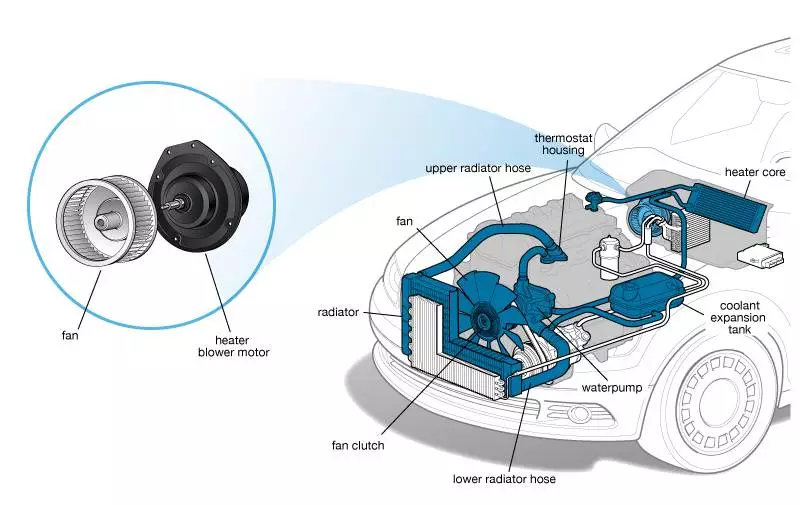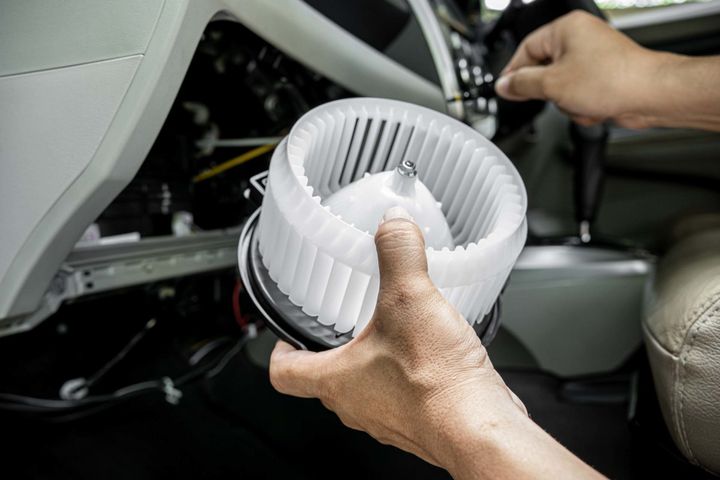


The blower motor is a crucial component of an HVAC system, responsible for circulating heated or cooled air throughout a building. When this motor fails, it can lead to inadequate heating or cooling, resulting in discomfort and potential damage to the system. Understanding the common reasons why a blower motor may stop working and the corresponding solutions is essential for homeowners and HVAC professionals alike.
In this comprehensive article, I'll share my expertise and insights into the common causes of blower motor failure, troubleshooting techniques, repair instructions, and preventive measures to help you understand and address this issue effectively.

The main causes of blower motor failure can be categorized into four common issues:
| Common Issue | Description |
|---|---|
| Blown Fuse | A small wire inside a connector that protects the motor from electrical surges. If the fuse is blown, the blower motor won't receive power and won't work on any speed. |
| Bad Ground Connection | The blower motor requires a proper ground connection to complete the electrical circuit. If the ground connection is loose or corroded, the motor won't function correctly. |
| Faulty Speed Control Module | For variable speed motors, the speed control module regulates the motor's speed. If this module fails, the motor may not run at all or run at only one speed. |
| Failed Motor | In some cases, the blower motor itself can fail due to wear and tear, overheating, or other mechanical issues. This is less common, but it can happen, especially in older vehicles. |
Blown Fuse: A fuse is a small wire inside a connector that protects the motor from electrical surges. If the fuse is blown, the blower motor won't receive power and won't work on any speed.
Bad Ground Connection: The blower motor requires a proper ground connection to complete the electrical circuit. If the ground connection is loose or corroded, the motor won't function correctly. This can cause intermittent operation, unusual noises, or reduced performance.
Intermittent operation
Unusual noises
Reduced performance
Faulty Speed Control Module: For variable speed motors, the speed control module regulates the motor's speed. If this module fails, the motor may not run at all or run at only one speed, making it impossible to adjust the airflow as desired.
Motor may not run at all
Motor runs at only one speed
Failed Motor: In some cases, the blower motor itself can fail due to wear and tear, overheating, or other mechanical issues. This is less common, but it can happen, especially in older vehicles with high mileage. A failed motor may produce grinding, squeaking, or no operation even when power and ground are connected.
Grinding noises
Squeaking noises
No operation even with power and ground connected
As a mechanic, I follow a systematic approach to troubleshooting and diagnosing blower motor issues. Here are the steps I typically take:
| Inspection Step | Description |
|---|---|
| Check the Fuse Box | Check the fuse box for a blown fuse related to the blower motor circuit. A blown fuse is often the culprit, and replacing it can resolve the issue quickly. |
| Inspect the Ground Connection | Carefully inspect the ground connection for looseness, corrosion, or damage. A bad ground can cause intermittent operation or reduced performance. |
| Test the Speed Control Module | For variable speed motors, test the speed control module by bypassing it with a direct power and ground connection. If the motor runs normally, the module is likely faulty and needs replacement. |
| Listen for Unusual Noises | Pay close attention to any unusual noises or signs of mechanical failure from the motor itself. Grinding, squeaking, or no operation even with power and ground connected can indicate a failed motor. |
Blown Fuse: No power to the blower motor at any speed setting.
Bad Ground: Intermittent operation, unusual noises, or reduced performance.
Faulty Module: Motor runs at only one speed or doesn't run at all.
Failed Motor: Grinding, squeaking, or no operation even with power and ground connected.
Once the root cause of the blower motor failure has been identified, it's time to perform the necessary repairs. Here are the typical repair instructions I follow:
| Repair | Instructions |
|---|---|
| Blown Fuse | Replace the blown fuse with a new one of the correct amperage rating. |
| Bad Ground | Clean the ground connection point, tighten any loose connections, or replace the ground wire if necessary. |
| Faulty Module | Replace the speed control module with a new one compatible with your vehicle. |
| Failed Motor | Replace the entire blower motor assembly with a new or remanufactured unit. |
Always disconnect the negative battery cable before working on electrical components to prevent short circuits or electrical shocks.
Follow the vehicle's service manual for specific instructions on accessing and replacing components to ensure proper installation and avoid potential damage.
Be careful when handling electrical connectors and wiring to avoid damage that could lead to further issues.
While blower motor failures are sometimes unavoidable, there are steps you can take to minimize the risk and prevent recurrence:

Check and replace fuses as needed during routine maintenance to ensure proper electrical protection.
Inspect and clean electrical connections periodically to prevent corrosion and ensure good ground connections.
Follow the manufacturer's recommended maintenance schedule for your vehicle to keep all components in optimal condition.
Avoid overloading the blower motor by keeping air vents and filters clear of obstructions, which can cause the motor to work harder and potentially overheat.
Use the appropriate speed settings for the desired airflow and temperature to prevent unnecessary strain on the motor.
The cost of repairing a blower motor can vary depending on the specific issue and the make and model of your vehicle. Here are some general cost estimates:
| Repair | Cost Range |
|---|---|
| Replacing a Fuse | $5 - $20 for the fuse, plus labor if you don't do it yourself. |
| Repairing a Ground Connection | $50 - $150 for parts and labor. |
| Replacing a Speed Control Module | $100 - $300 for the part, plus labor. |
| Replacing the Blower Motor Assembly | $200 - $600 for the part, plus labor. |
Labor costs can range from $50 to $150 per hour, depending on the repair shop and your location. It's always a good idea to get multiple quotes and consider the cost of parts and labor when deciding whether to repair or replace the blower motor assembly.
Blower motor failure is a common issue that can significantly impact your driving comfort and experience. As a mechanic, I've seen firsthand the frustration it can cause, but also the relief that comes with proper diagnosis and repair. By understanding the main causes, troubleshooting techniques, repair instructions, and preventive measures, you can be better prepared to address this issue should it arise.
Remember, regular maintenance, proper usage, and seeking professional assistance when needed can go a long way in ensuring your vehicle's HVAC system operates smoothly and efficiently. Don't hesitate to consult with a trusted mechanic if you encounter any issues with your blower motor or have concerns about the overall condition of your vehicle.
Common causes include worn bearings, electrical issues like a faulty capacitor, and motor winding failures. Lack of lubrication and overheating can also lead to blower motor failure.
Signs of a failing blower motor include weak airflow, unusual noises from the HVAC system, and the motor not spinning at all speeds. Smoke or burning smells indicate an urgent need for replacement.
Yes, lubricating the blower motor is a task many homeowners can do themselves by accessing the motor, cleaning it, and applying the recommended lubricant to the oil ports.
Follow the manufacturer's recommendations, but most blower motors should be lubricated annually as part of routine HVAC maintenance.
Use the lubricant type specified in your furnace's owner's manual, which is typically a spray lubricant or grease designed for blower motor applications.
Turn off power to the furnace, remove the access panel, unfasten the blower motor, and carefully pull it out while avoiding stretching the wires.
Yes, accumulated dirt and debris on the blower motor can lead to overheating, excessive noise, and reduced efficiency, so regular cleaning is important.
Replacement blower motor costs can range from $120 to over $1,000, depending on the motor type, furnace brand, and labor costs.
Replacing a blower motor is generally not recommended for DIYers unless you have HVAC experience, as it involves working with electrical components and proper motor installation.
If you notice any signs of blower motor failure, it's best to call an HVAC technician for diagnosis and repair or replacement to ensure safety and proper operation.

Sarah isn't your average gearhead. With a double major in Mechanical Engineering and Automotive Technology, she dived straight into the world of car repair. After 15 years of turning wrenches at dealerships and independent shops, Sarah joined MICDOT to share her expertise and passion for making cars run like new. Her in-depth knowledge and knack for explaining complex issues in simple terms make her a valuable asset to our team.











